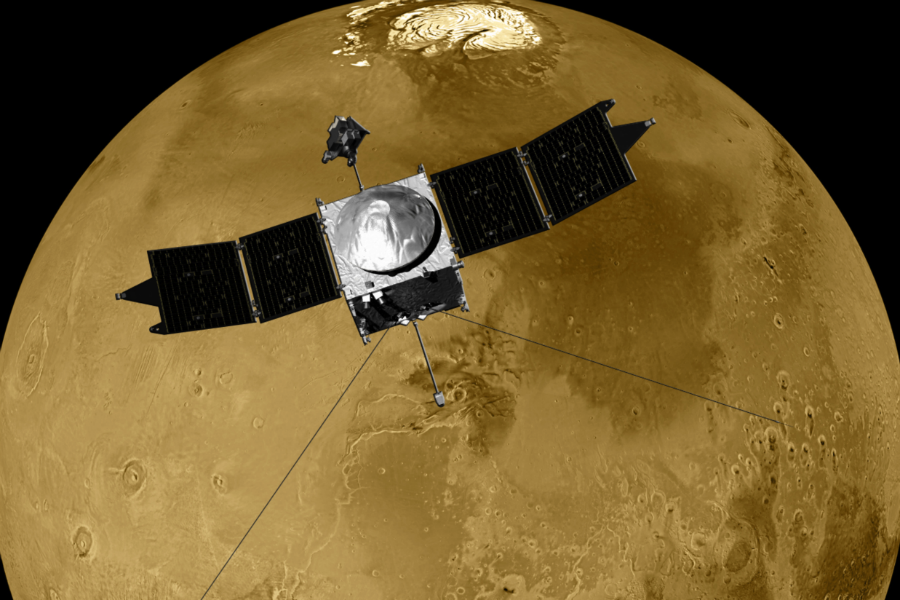NASA's MAVEN: First results from mission to Mars dazzle scientists
Loading...
NASA's newest Mars orbiter, MAVEN, has returned its first observations of the red planet's upper atmosphere, laying a promising foundation for answering a nagging question about the planet's environment: What happened to an atmosphere that supported a warm and wet planet some 4 billion years ago, only to become the dry, chilled desert that astronomers see today?
Although its science mission has yet to begin, the craft already has revealed clues with the first detailed measurements of the upper atmosphere's hydrogen, oxygen, and carbon, which back in the day would have appeared as water vapor and carbon dioxide – two potent gases for trapping heat near the surface.
This would have allowed liquid water to remain stable on the surface, providing potential habitats for microbial life.
Following its arrival at Mars Sept. 21, the craft also recorded the passage of a blast of energetic particles that erupted from the sun on Sept. 30 in an event known as a coronal-mass ejection, the most powerful solar storms that the sun generates. Such storms are thought to have played an important role in altering Mars' climate by depositing large amounts of energy in the upper atmosphere, splitting water and CO2 molecules and ejecting the hydrogen into space.
MAVEN, short for Mars Atmosphere and Volatile Evolution, is still in its shakedown phase. All instruments are working but are in need of final adjustments before they begin to take measurements in a coordinated fashion starting in November.
Still, during its first few weeks on orbit, MAVEN has given the science team its first look at the structure of the extended upper atmosphere and the distribution of the three key atoms, some of which are escaping, said Bruce Jakosky, a University of Colorado astrobiologist and the mission's lead scientist, during a briefing Tuesday.
In addition, “we're starting to see the processes that drive the escape,” he said. Those processes are likely to have been more intense in the past, when a younger sun was more active than it is today.
The team is seeing these clues to Mars' atmospheric history with unexpected clarity.
For instance, MAVEN's Imaging Ultraviolet Spectrograph recorded an extended, if tenuous, envelope of hydrogen atoms around Mars that extends as far as 21,000 miles from the planet – easy pickings for stripping, because the atom is so light and thus is less tightly bound by the planet's gravity than is oxygen or carbon.
While MAVEN showed that Mars holds the upper atmosphere's inventory of carbon and oxygen much closer to its gravitational vest, the craft also revealed an extended envelope of oxygen above the sunlit hemisphere. This so-called hot oxygen has been energized through photochemical reactions that the sun's light triggers. Some of this extended oxygen gets stripped from Mars, as well.
“The quality of the data is better than we were expecting,” said Justin Deighan, a researcher at the University of Colorado at Boulder and one of the MAVEN scientists working with the craft's Imaging Ultraviolet Spectrograph. “The ability to see that high-altitude oxygen – we were hoping for it, but we could never have guessed how good that picture would come out.”
Since oxygen comes from the breakup of water and carbon dioxide molecules, “we need to understand it for a complete story of atmospheric escape from Mars,” he said.
MAVEN also returned a map of the distribution of ozone in the lower atmosphere above the planet's south pole. It's a key piece of the puzzle, the researchers say, because ozone is vulnerable to water vapor and sunlight, which break up ozone molecules.
The relative abundance of ozone shows the team “where water is and is not present,” Dr. Deighan explained, and it reveals the chemical processes taking place in the lower atmosphere. Those processes are responsible for breaking water up into its constituent atoms – the initial step of hydrogen and oxygen – and carrying them into the upper atmosphere, where they can be carried off into space.
Making such measurements simultaneously with measurements of the upper atmosphere several times a day over the next year “will allow us to understand how Mars' atmosphere is being lost today and, by extension, how much has been lost over the history of the solar system," he adds.








